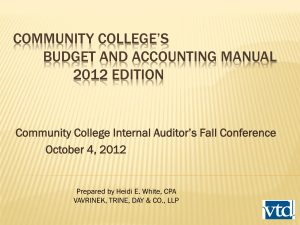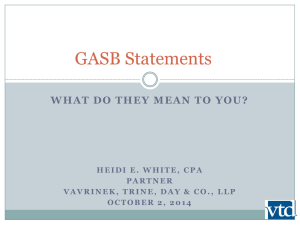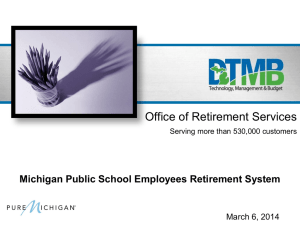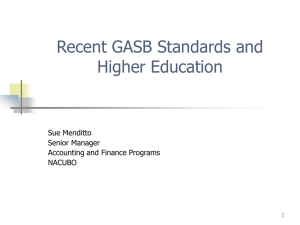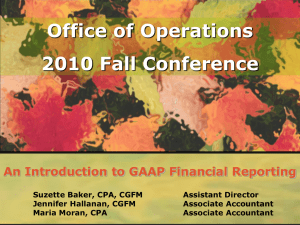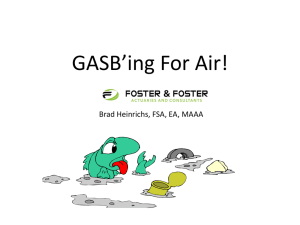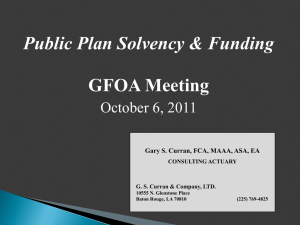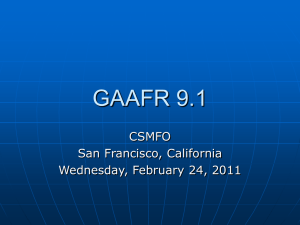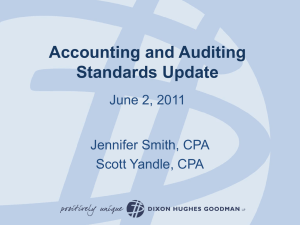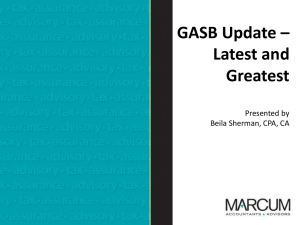ppt - 794 kb
advertisement
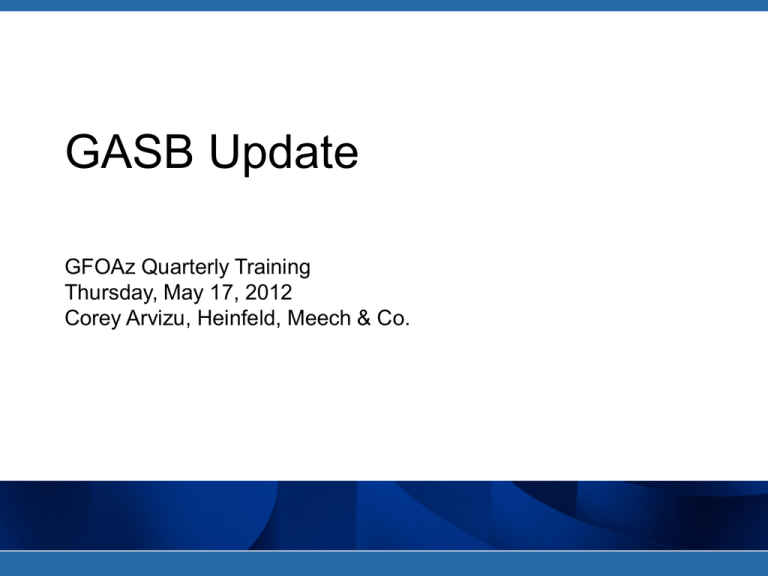
GASB Update GFOAz Quarterly Training Thursday, May 17, 2012 Corey Arvizu, Heinfeld, Meech & Co. Speaker Bio Corey Arvizu is a partner in the Tucson, Arizona office of the accounting firm Heinfeld, Meech & Co. and is the former chairperson of the AICPA’s Governmental Audit Quality Center Executive Committee. Corey manages audit services for municipalities, school districts, insurance funds, pension plans and not-for-profit organizations in both Arizona and New Mexico. In his role as a partner Corey provides guidance and training on accounting and auditing issues including GASB pronouncements, auditing standards, Government Auditing Standards, and Single Audits. 2 GASB What is the GASB? The Governmental Accounting Standards Board (GASB) is the independent organization that establishes and improves standards of accounting and financial reporting for U.S. state and local governments. The GASB is recognized by governments, the accounting industry, and the capital markets as the official source of generally accepted accounting principles (GAAP) for state and local governments. 3 GASB How is the GASB funded? The GASB is not a government entity; instead, it is an operating component of the Financial Accounting Foundation, which is a private sector not-for-profit entity. Funding for the GASB comes in part from sales of its own publications and in part from state and local governments and the municipal bond community. 4 GASB Are the GASB rules the law? GASB standards are not federal laws or regulations and the organization does not have enforcement authority. Compliance with GASB’s standards, however, is enforced through the laws of some individual states and through the audit process, when auditors render opinions on the fairness of financial statement presentations in conformity with GAAP. 5 GASB How does the GASB set standards? Before issuing its standards, the GASB follows the due process activities described in its published Rules of Procedure. The GASB’s stringent due process activities are designed to encourage broad public participation in the standards-setting process. The process includes appointing an advisory task force of outside experts, performing research, publishing discussion documents, and conducting public hearings. 6 GASB How else does GASB communicate information? Website—www.gasb.org. The GASB makes a variety of resources available through its website, including up-to-date information about current agenda projects and major recent pronouncements, summaries of GASB pronouncements, and free copies of proposals. The GASB Report. The GASB strives to keep the public informed of developments on its projects through a monthly newsletter. Plain-Language Articles. Proposed and final GASB standards are typically accompanied by an explanatory article that uses a minimum of technical language and focuses on both the requirements of the document and the rationale for issuing it. 7 GASB 54 – Fund Balance Reporting and Governmental Fund Type Definitions Stabilization arrangements may not be assigned General ledger and financial statements may differ Transfers not considered revenues for the purpose of determining special revenue funds • However, transfers are considered “inflows” for the purpose of calculating if actual restricted/committed revenues are a substantial portion of the funds resources Use of special revenue funds not required • Except general fund of component unit and if legally mandated General Fund budgetary comparison should not include other funds included in the General Fund for GAAP reporting 8 GASB 57 – OPEB Measurements by Agent Employers and Agent Plans Permits small plans to use alternative method regardless of the size of total agent plan members Permits agent multiple employer plan to aggregate such valuations Agent plan should require participating employers to measure on same frequency and on a common date Effective for fiscal year 2012 9 GASB 64 – Derivative Investments: Application of Hedge Accounting Termination Provisions – an amendment to GASB No. 53 Clarifies whether a hedging relationship continues in certain circumstances Hedgeable item – instrument that reduces risk by offsetting changes in cash flows or fair values Hedge accounting – requires change in fair value of hedgeable item to be deferred Effective for fiscal year 2012 10 GASB 60 – Service Concession Arrangements (SCA) Guidance for certain agreements between governments and private entities or other governments GASB partnered with international standard setters in development Excellent flowchart included in standard Effective for fiscal year 2013 11 GASB 60 – Service Concession Arrangements Use of infrastructure or other public asset is a required element Provides guidance on capital asset recognition and depreciation by the government Recognition of liabilities for obligations under the arrangement Guidance for governmental operators to recognize intangible assets (right to use facility) Note disclosure requirements 12 GASB 60 – Service Concession Arrangements Definition – 1) Government conveys to an operator right to provide services through use of asset/facility in exchange for significant consideration, 2) The operator collects fees from third parties for service provided, and 3) The government has input on services provided by the operator and the fees charged for services. 13 GASB 60 – Service Concession Arrangements Examples – 1) State transportation department enters into arrangement with a transportation authority for the operation of a tollway. Authority to receive and retain revenues for a period of 75 years. 2) A City enters into arrangement with a private company for the operation of City owned golf courses. The private company agrees to pay the City 10% of revenues for 10 years. 3) County entering into an arrangement for a City to design, build and operate a new jail facility. The County will collect and retain all fees for a period of 40 years. 14 GASB 60 – Service Concession Arrangements Not within the scope of an SCA 1) Third party designs and builds a capital asset 2) Concessions or other ancillary services operated in conjunction with a government facility 3) Service and management arrangement services the government would otherwise perform 15 GASB 61 – Reporting Entity Issued November 2010 Objective – amend component unit guidance for specific issues which have arisen Modifies certain requirements for inclusion of component units Effective for fiscal year 2013 16 GASB 61 – Reporting Entity New blending requirement if CU total debt to be repaid from PG resources “Incomplete” removed from misleading guidance Enhanced guidance on “major” component unit presentation Note disclosure should focus on rationale for inclusion rather than the criteria Explain which criteria apply to the component unit 17 GASB 61 – Reporting Entity Blended Component Unit – The financial reporting entity presented in these financial statements consists of the Town and the Town of Old Pueblo Municipal Property Corporation (MPC) blended component unit. The MPC, a non-profit corporation incorporated under the laws of the State of Arizona, was originally formed for the purpose of assisting the Town in obtaining financing for acquiring certain water companies. The Town has a contractual obligation for the repayment of the MPC’s Municipal Facilities Revenue Bonds, therefore the MPC is included in the Town’s reporting entity as a blended component unit because the component unit's total debt outstanding is expected to be repaid entirely with resources of the Town of Old Pueblo. The activity of the MPC is reported in the applicable water enterprise fund. Separate financial statements are not prepared for the component unit on a stand-alone basis. 18 Additional financial criteria added Component unit flowchart “Incomplete” removed from criteria Debt repayment requirement added 19 GASB 62 – Codification of FASB Standards Issued December 2010 Guidance to incorporate pre-1989 FASB and related standards into GASB’s literature Exposure draft over 600 pages Option to apply post-1989 FASB removed See Basis for Conclusions for standards excluded from the codification Effective for fiscal year 2013 20 GASB 62 – Codification of FASB Standards Key areas for which guidance is provided – • Capitalization of Interest Cost • Statement of Net Assets Classification • Accounting Changes and Error Corrections • Contingencies • Leases • Sale of Real Estate • Special and extraordinary items • Inventory 21 GASB 63 – Deferred Outflow and Inflows of Resources Result of definitions introduced in GASB Concepts Statement No. 4, Elements of Financial Statements Concept of “net position” replaces “net assets” Note disclosure required if deferred items are aggregated on the face of the financial statements Effective for fiscal year 2013 • Limited to GASB 53 and 60 initially • More widespread application upon implementation of GASB 65 22 GASB 63 – Deferred Outflow and Inflows of Resources The elements of a statement of financial position are defined as follows: • Assets are resources with present service capacity that the government presently controls. • Liabilities are present obligations to sacrifice resources that the government has little or no discretion to avoid. • A deferred outflow of resources is a consumption of net assets by the government that is applicable to a future reporting period. • A deferred inflow of resources is an acquisition of net assets by the government that is applicable to a future reporting period. • Net position is the residual of all other elements presented in a statement of financial position. 23 TOWN OF OLD PUEBLO, ARIZONA STATEMENT OF NET POSITION JUNE 30, 2013 Governmental Activates ASSETS Current assets: Cash and cash equivalents Taxes receivable Accounts receivable Intergovernmental receivable Total current assets $ Noncurrent assets: Capital assets, non-depreciable Capital assets, depreciable (net) Total noncurrent assets Total assets DEFERRED OUTFLOWS OF RESOURCES Accumulated decrese in fair value of hedging derivatives LIABILITIES Current liabilities: Accounts payable Accrued wages and benefits Unearned revenue Compensated absences Loans payable Revenue bonds Total current liabilities Noncurrent liabilities: Compensated absences Loans payable Revenue bonds Total noncurrent liabilities Total liabilities 23,065,362 718,368 362,153 969,057 25,114,940 Business-type Activates $ 2,190,093 458,909 22,181,101 42,597,461 718,368 2,552,246 1,427,966 47,296,041 20,656,679 124,882,390 145,539,069 170,654,009 15,342,777 79,939,857 95,282,634 117,463,735 35,999,456 204,822,247 240,821,703 288,117,744 392,398 2,472,096 2,864,494 2,781,875 782,563 128,180 1,234,551 2,513,133 304,820 7,745,122 697,374 95,129 114,293 307,670 2,370,180 3,584,646 3,479,249 877,692 128,180 1,348,844 2,820,803 2,675,000 11,329,768 58,878 5,165,426 48,367,660 53,591,964 57,176,610 407,084 5,165,426 55,281,943 60,854,453 72,184,221 1,990,112 1,990,112 1,990,112 1,990,112 40,304,244 173,887,638 20,464,865 60,769,109 626,098 3,654,948 4,426,071 34,212,350 216,807,105 348,206 6,914,283 7,262,489 15,007,611 DEFERRED INFLOWS OF RESOURCES Deferred service concession arragement receipts Total deferred inflows of resources NET POSITION Net investment in capital assets Restricted for: Public safety Highways and streets Debt service Unrestricted Total net position 133,191,796 $ 626,098 3,654,948 4,426,071 13,747,485 155,646,398 $ 19,532,099 Total $ $ 24 GASB 65 – Items Previously Reported as Assets and Liabilities Expands the use of deferred inflows and outflows of resources to other items Certain elements apply to governmental fund statements Use of term “deferred” limited to deferred outflows/inflows of resources Does not impact fund balance reporting Effective for fiscal year 2014 25 GASB 65 – Items Previously Reported as Assets and Liabilities Application items common to local governments • Deferred outflow – difference between carrying value of debt and the amount to refunded debt (if debit) • Deferred inflow – “unavailable” related to the application of modified accrual accounting • Neither an asset or deferred outflow – debt issuance costs to be reported as an expense 26 TOWN OF OLD PUEBLO, ARIZONA STATEMENT OF NET POSITION JUNE 30, 2014 ASSETS Current assets: Cash and cash equivalents Taxes receivable Accounts receivable Intergovernmental receivable Total current assets Governmental Activates Business-type Activates $ $ Noncurrent assets: Capital assets, non-depreciable Capital assets, depreciable (net) Total noncurrent assets Total assets DEFERRED OUTFLOWS OF RESOURCES Deferred item on refunded debt LIABILITIES Current liabilities: Accounts payable Accrued wages and benefits Unearned revenue Compensated absences Loans payable Revenue bonds Total current liabilities Noncurrent liabilities: Compensated absences Loans payable Revenue bonds Total noncurrent liabilities Total liabilities 2,190,093 458,909 22,181,101 42,597,461 718,368 2,552,246 1,427,966 47,296,041 20,656,679 124,882,390 145,539,069 170,654,009 15,342,777 79,939,857 95,282,634 117,463,735 35,999,456 204,822,247 240,821,703 288,117,744 392,398 2,472,096 2,864,494 2,781,875 782,563 128,180 1,234,551 2,513,133 304,820 7,745,122 697,374 95,129 114,293 307,670 2,370,180 3,584,646 3,479,249 877,692 128,180 1,348,844 2,820,803 2,675,000 11,329,768 6,914,283 7,262,489 15,007,611 58,878 5,165,426 48,367,660 53,591,964 57,176,610 407,084 5,165,426 55,281,943 60,854,453 72,184,221 - 1,990,112 1,990,112 1,990,112 1,990,112 132,956,156 40,005,568 172,961,724 20,464,865 60,470,433 626,098 3,654,948 4,426,071 34,212,350 215,881,191 348,206 DEFERRED INFLOWS OF RESOURCES Proceeds from sale of future revenues Total deferred inflows of resources NET POSITION Net investment in capital assets Restricted for: Public safety Highways and streets Debt service Unrestricted Total net position 23,065,362 718,368 362,153 969,057 25,114,940 $ 626,098 3,654,948 4,426,071 13,747,485 155,410,758 $ 19,532,099 Total $ $ 27 TOWN OF OLD PUEBLO, ARIZONA BALANCE SHEET - GOVERNMENTAL FUNDS JUNE 30, 2014 General Fund Receipt of expenditure-driven grants in advance of incurred eligible costs ASSETS Cash and cash equivalents Taxes receivable Accounts receivable Intergovernmental receivable Special assessments Prepaid items Total assets LIABILITIES, DEFERRED INFLOWS OF RESOURCES AND FUND BALANCES Liabilities: Accounts payable Accrued wages and benefits Intergovernmental payable Advance from grantor Customer deposits payable Total liabilities $ $ $ Deferred inflows of resources: Deferred grant revenues Total deferred inflows of resources Reimbursement grants received after the period of availability 11,180 14,224,638 1,944,997 687,168 361,283 128,180 95,872 3,217,500 $ 14,224,638 $ $ 4,138,674 14,993 $ 4,143,104 $ 4,153,667 $ $ 414,236 73,920 $ 324,735 16,204 $ $ 20,588,837 718,368 362,153 840,871 11,180 22,521,409 488,156 571,195 2,683,968 777,292 361,283 358,436 95,872 4,276,851 15,777 15,777 55,889 55,889 146,881 146,881 3,639,171 2,685,879 840,704 3,639,171 3,526,583 6,325,050 840,704 1,769,333 9,162,590 18,097,677 230,256 1,769,333 9,162,590 10,931,923 $ 3,887,479 Total Governmental Funds 7,551 248,074 75,215 75,215 Fund balances: Restricted Committed Assigned Unassigned Total fund balances Total liabilities, deferred inflows and fund balances 12,562,684 718,368 354,602 577,804 HURF Non-Major Governmental Funds 4,143,104 $ 4,153,667 $ 27,989,306 28 GASB 66 – Technical Corrections – 2012 an amendment to GASB Statements No. 10 and No. 62 Eliminates requirement that risk financing activities be accounting for in either the general fund or an internal service fund • Special revenues funds may be used Corrections to GASB No. 62 for – • Operating leases • Purchase of a loan • Servicing fees Effective for fiscal year 2014 29 Pension Accounting and Financial Reporting Exposure Draft Governments will be required to report their calculated share of the pension plan’s unfunded obligations Measurement is accounting-based rather than funding-based Will be applicable to many local governments Numerous comment letters provided to GASB Additional disclosures regarding funding process deliberated by ultimately not adopted Cleared for issuance 30 Government Combinations and Disposals Exposure Draft Specific accounting and financial reporting guidance for mergers, acquisitions, and transfer of operations Prior guidance provided by Accounting Principles Board (APB) Opinion No. 16 Note disclosure guidance Gains or losses on disposal of operations reported as a special item Comment deadline is June 15, 2012 Planned effective date for fiscal year 2015 31 Economic Condition Reporting: Financial Projections Preliminary Views Propose presentation of certain economic condition information as required supplementary information Format of information presented similar to statistical schedules of a CAFR Appropriateness as RSI, impact on timeliness of reporting, and cost-benefits among factors considered Strong “cautionary note” prior to information is being proposed Currently in deliberation 32 Economic Condition Reporting: Financial Projections Preliminary Views Components of fiscal sustainability information 1) Projections of cash inflows 2) Projections of cash outflows 3) Projections of financial obligations (bonds, pensions, long-term contracts, etc.) 4) Projections of annual debt service payments (principal and interest) 5) Narrative discussion of major intergovernmental service interdependencies 33 Other GASB Projects • In deliberation – • • • • • • In research – Conceptual framework OPEB accounting and reporting Fair value measurements Financial guarantees GAAP hierarchy • • • • Electronic financial reporting Fiduciary responsibilities Lease accounting Tax abatement disclosures • Potential projects – • • • • • Interim reporting Popular reporting Reporting unit presentations In-kind contributions Present value 34 Thank you Corey Arvizu Heinfeld, Meech & Co. 520-742-2611 carvizu@heinfeldmeech.com 35
